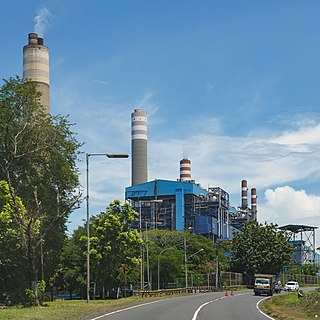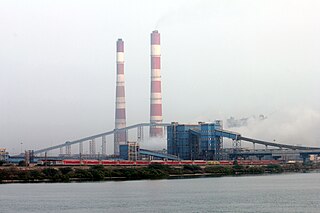Related Research Articles

The Hub Power Company Limited, colloquially known as HUBCO, is the first and largest Independent Power Producer (IPP) in Pakistan, with a combined installed power generation capacity of 3,581 MW.

PT Perusahaan Listrik Negara (Persero) (lit. 'State Electricity Company', abbreviated as PLN) is an Indonesian government-owned corporation which has a monopoly on electric power distribution in Indonesia and generates the majority of the country's electrical power, producing 176.4 TWh in 2015. It was included in the Fortune Global 500 lists of 2014 and 2015. It has large debts due to expensive coal power contracts.

Denmark was a pioneer in developing commercial wind power during the 1970s, and today a substantial share of the wind turbines around the world are produced by Danish manufacturers such as Vestas—the world's largest wind-turbine manufacturer—along with many component suppliers. Furthermore, Denmark has - as of 2022 - the 2nd highest amount in the world of wind power generation capacity installed per capita, behind only neighboring Sweden.

A gas-fired power plant, sometimes referred to as gas-fired power station, natural gas power plant, or methane gas power plant, is a thermal power station that burns natural gas to generate electricity. Gas-fired power plants generate almost a quarter of world electricity and are significant sources of greenhouse gas emissions. However, they can provide seasonal, dispatchable energy generation to compensate for variable renewable energy deficits, where hydropower or interconnectors are not available. In the early 2020s batteries became competitive with gas peaker plants.
A feed-in tariff is a policy mechanism designed to accelerate investment in renewable energy technologies by offering long-term contracts to renewable energy producers. This means promising renewable energy producers an above-market price and providing price certainty and long-term contracts that help finance renewable energy investments. Typically, FITs award different prices to different sources of renewable energy in order to encourage the development of one technology over another. For example, technologies such as wind power and solar PV are awarded a higher price per kWh than tidal power. FITs often include a "digression": a gradual decrease of the price or tariff in order to follow and encourage technological cost reductions.
PT Pertamina Gas Negara Tbk is an Indonesian natural gas transportation and distribution company. The total length of distribution pipelines of the company is 3,187 km that serve around 84 million customers.

The Wilton power station refers to a series of coal, oil, gas and biomass fired CHP power stations which provide electricity and heat for the Wilton International Complex, with excess electricity being sold to the National Grid. It is located on the Wilton site in Redcar and Cleveland, south of the town of Middlesbrough in North East England. The station has provided for the site since opening in 1952, when it was operated by ICI. The station is currently owned and operated by SembCorp Industries.

Geothermal power in Indonesia is an increasingly significant source of renewable energy. As a result of its volcanic geology, it is often reported that Indonesia has 40% of the world's potential geothermal resources, estimated at 28,000 megawatts (MW).

In 2019, the total energy production in Indonesia is 450.79 Mtoe, with a total primary energy supply is 231.14 Mtoe and electricity final consumption is 263.32 TWh. Energy use in Indonesia has been long dominated by fossil resources. Once a major oil exporter in the world and joined OPEC in 1962, the country has since become a net oil importer despite still joined OPEC until 2016, making it the only net oil importer member in the organization. Indonesia is also the fourth-largest biggest coal producer and one of the biggest coal exporter in the world, with 24,910 million tons of proven coal reserves as of 2016, making it the 11th country with the most coal reserves in the world. In addition, Indonesia has abundant renewable energy potential, reaching almost 417,8 gigawatt (GW) which consisted of solar, wind, hydro, geothermal energy, ocean current, and bioenergy, although only 2,5% have been utilized. Furthermore, Indonesia along with Malaysia, have two-thirds of ASEAN's gas reserves with total annual gas production of more than 200 billion cubic meters in 2016.
South Africa has a large energy sector, being the third-largest economy in Africa. The country consumed 227 TWh of electricity in 2018. The vast majority of South Africa's electricity was produced from coal, with the fuel responsible for 88% of production in 2017. South Africa is the 7th largest coal producer in the world. As of July 2018, South Africa had a coal power generation capacity of 39 gigawatts (GW). South Africa is the world's 14th largest emitter of greenhouse gases. South Africa is planning to shift away from coal in the electricity sector and the country produces the most solar and wind energy by terawatt-hours in Africa. The country aims to decommission 34 GW of coal-fired power capacity by 2050. It also aims to build at least 20 GW of renewable power generation capacity by 2030. South Africa aims to generate 77,834 megawatts (MW) of electricity by 2030, with new capacity coming significantly from renewable sources to meet emission reduction targets. Through its goals stated in the Integrated Resource Plan, it announced the Renewable Energy Independent Power Producer Procurement Programme, which aims to increase renewable power generation through private sector investment.
Mundra Ultra Mega Power Project or Mundra UMPP is a subbituminous coal-fired power plant in Tunda village at Mundra, Kutch district, Gujarat, India. It is the 3rd largest operational power plant in India. The coal for the power plant is imported primarily from Indonesia. The source of water for the power plant is sea water from Gulf of Kutch. The power plant is owned by Tata Power. The special purpose vehicle Coastal Gujarat Power Ltd (CGPL) was incorporated on 10 February 2006.

The electricity sector in Taiwan ranges from generation, transmission, distribution and sales of electricity, covering Taiwan island and its offshore islands.

Paiton Power Station is a large thermal power station located around 35 km to the east of the town of Probolinggo in East Java in Indonesia, about half way between Probolinggo and Situbondo. The extensive complex has a maximum generating capacity of 4,710 megawatts. It is the largest power station in Indonesia and the 10th largest coal-fired power station in the world.

Vallur Thermal Power Station is a power plant located in Vallur, Thiruvallur district, India. The power plant is operated by NTPC Tamil Nadu Energy Company Limited, a joint venture between NTPC Limited and TANGEDCO and has three units with 500 MW each.
The Sahiwal Coal Power Project is a coal power plant project located in the province of Punjab in Pakistan by the name of Huaneng Shandong Ruyi (Pakistan) Energy (Limited). It has an installed capacity of 1320 MW. It commenced full operations on 3 July 2017.

PT Bekasi Power is a power plant located in West Java, Indonesia. It is a subsidiary of PT Jababeka Tbk which was established in 2007. As a 130 megawatt (MW) power plant generated by steam and gas (PLTGU), it strengthens Bekasi – Karawang electricity system through Cibatu substation owned by PT Perusahaan Listrik Negara (PLN). This state-owned company can only meet the needs of about 60 percent. To meet the rest, private sector needs to get involved. A reliable and sustainable electricity supply with an international standard is a must for an industrial estate. Bekasi Power plant is therefore constructed to guarantee Uninterruptible Power Supply (UPS) for a total of seven industrial zones including Jababeka. By delivering reliable electricity at a competitive price, this plant supports Jababeka business as well as surrounding areas, boosting Indonesia's power capacity and industrial growth for the upcoming years.
Burning of charcoal and wood fuel provides approximately 94 percent of the energy in Malawi. Much of the renewable hydroelectric potential of the country is untapped. As per 2018 Population and Housing Census, the national electrification rate in Malawi was 10%, with 37% of the urban population and only 2% of the rural population having access to electricity.

The 2019 Java blackout was a power outage that occurred across much of Java on August 4, 2019 11:50 (UTC+7) to August 5, 2019 at 22:00 (UTC+7).
Blackburn power stations are a series of electricity generating stations that have provided electric power to the town of Blackburn and the wider area from 1895 to the present. The first station in Jubilee Street, Blackburn began operating in 1895. A new larger station known as Blackburn East or Whitebirk power station was commissioned in 1921 and was rebuilt in stages over the period 1942 to 1955. Whitebirk station closed in 1976. The 60 MW Blackburn Mill Combined Cycle Gas Turbine (CCGT) power station has generated electricity since 2002. The Blackburn energy from waste (EfW) plant is currently (2020) being planned.
References
- ↑ Amahl S. Azwar, Cirebon power plant on stream for Java and Bali', The Jakarta Post, 19 October 2012.
- ↑ "ADB and Indonesia Partners Sign Landmark MOU on Early Retirement Plan for First Coal Power Plant Under Energy Transition Mechanism". Asian Development Bank. 2022-11-14. Retrieved 2023-07-19.